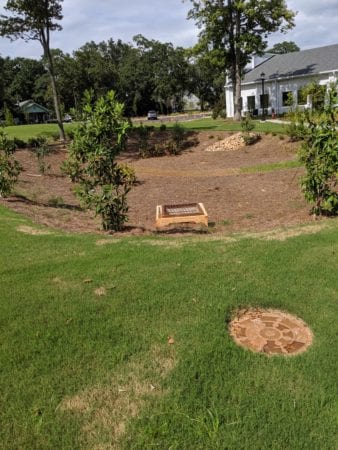Unless your property is getting flooded from a neighboring property or you are developing a parcel, you probably do not think about stormwater management very often.
Stormwater management is one of the core areas in civil design. The development of a site almost always increases the impervious area through the construction of things such as buildings, parking lots, and sidewalks, which prevents stormwater from soaking into the ground and increases runoff volumes. The basic principle that we design by is the rate at which stormwater flows off a site must be less than it was before construction. We as civil engineers analyze the amount of stormwater in different areas in and around the site to ensure that our design will accomplish this goal. One of the stormwater management tools at our disposal is a detention pond, also known as a dry pond.
 A dry pond is the most basic and common stormwater management device. A dry detention pond is essentially a pond that acts as a bathtub for temporarily storing stormwater and controlling the amount leaving the pond and property. An outlet structure called a “riser” is constructed at the lowest point of the pond to allow water to flow out of the pond. A riser is a usually cylindrical structure rising up out of the pond and is used to control the amount of water flowing out of the pond. The riser will have different sized orifice holes and notches in it at varying heights. The size and location of these holes are designed to release water at different rates depending on how much rain flows into the pond. The term “dry” comes from the fact that the smallest small hole is typically 2-4” across and is usually at the very bottom of the outlet structure. The only time the pond has any standing water is after a large rainfall event where water is still draining through one or more orifices.
A dry pond is the most basic and common stormwater management device. A dry detention pond is essentially a pond that acts as a bathtub for temporarily storing stormwater and controlling the amount leaving the pond and property. An outlet structure called a “riser” is constructed at the lowest point of the pond to allow water to flow out of the pond. A riser is a usually cylindrical structure rising up out of the pond and is used to control the amount of water flowing out of the pond. The riser will have different sized orifice holes and notches in it at varying heights. The size and location of these holes are designed to release water at different rates depending on how much rain flows into the pond. The term “dry” comes from the fact that the smallest small hole is typically 2-4” across and is usually at the very bottom of the outlet structure. The only time the pond has any standing water is after a large rainfall event where water is still draining through one or more orifices.
A lot more time and analysis goes into designing one of these ponds than the average person may think. Countless equations are utilized, as well as special software that is used to see how these ponds will behave in different sized storms. Each pond must meet specific requirements set by government entities such as SCDHEC and Greenville County Land Development. The next time you are in the parking lot of a grocery store, restaurant, or retail store, look around. Chances are there is a stormwater management pond close by that is ensuring the safety of the public by eliminating potential flooding issues caused by the parking lots and building areas.






Carolyn farley
Why are these dry ponds being put in the middle of the poorest residential area of linden? Aren’t they usually put near businesses? After a while who is going to care for the appearances of these spots? These are put right between two homes.